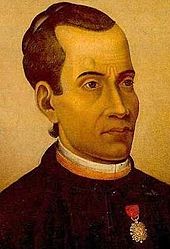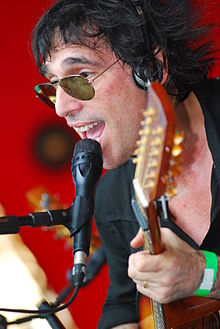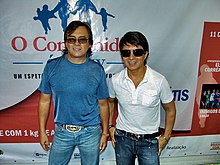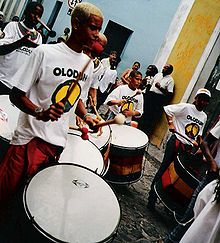Music of Brazil
This article has multiple issues. Please help improve it or discuss these issues on the talk page. (Learn how and when to remove these template messages)
|
| Part of a series on the |
| Culture of Brazil |
|---|
 |
| Society |
|
| Topics |
|
| Symbols |
The music of Brazil encompasses various regional musical styles influenced by European,
Samba has become the most known form of Brazilian music worldwide, especially because of the country's
The first four winners of the Shell Brazilian Music prize[1] have each left a legacy on Brazilian music and are among the representatives of Brazilian popular music: Pixinguinha (choro), Antônio Carlos Jobim (bossa nova), Dorival Caymmi (samba and samba-canção).
Instrumental music is also largely practiced in Brazil, with styles ranging from classical to popular and jazz influenced forms. Among the later, Naná Vasconcelos, Pixinguinha, Hermeto Pascoal and Egberto Gismonti are significant figures. Notable classical composers include Heitor Villa-Lobos, Carlos Gomes and Cláudio Santoro. The country also has a growing community of modern/experimental composition, including electroacoustic music.
History
Art music
Origins
Little is known of the music of Brazil before the area's first encounter with Portuguese explorers on 22 April 1500. During the colonial period, documents detail the musical activities of the major Roman Catholic cathedrals and the parlors of the upper classes, but data about musical life outside these domains are sparse. Some information is available in writings left by such travellers as Jean de Léry, who lived in Brazil from 1557 to 1558 and produced the first known transcriptions of native American music: two chants of the Tupinambá, near Rio de Janeiro.[2]

Further registration of musical activity in Brazil came from the activities of two
One century later, the Reduções of the southern Brazil, which were founded by Spaniard Jesuits, had a strong cultural development, where some music schools were founded. Some of the reports of that time show the fascination of the indigenous people for European music.[3] The indigenous people also took part in the music, with both the construction of musical instruments and practice of vocal and instrumental performance.
The 18th-century school

In the 18th century, there was intense musical activity in all the more developed regions of Brazil, with their moderately stable institutional and educational structures. The previously few private orchestras became more common and the churches presented a great variety of music.
In the first half of this century, the most outstanding works were composed by Luís Álvares Pinto, Caetano de Mello de Jesus and
In the second part of the 18th century, there was a great flourishing in
With the impoverishment of the mines at the end of the century, the focus of the musical activity changed to other centers, specially Rio de Janeiro and São Paulo, where André da Silva Gomes, a composer of Portuguese origin, released a great number of works and dynamized the musical life of the city.
Also, the oldest Orchestra of all Americas is situated in São João del-Rei, Minas Gerais, called Lira Sanjoanense, conducted, today, by Modesto Flávio Fonseca.
The Classical period

A crucial factor for the changes in the musical life was the arrival of the Portuguese Royal family to Rio de Janeiro in 1808. Until then, Rio de Janeiro was musically similar to other cultural centers of Brazil but was even less important than Minas Gerais. The presence of the Portuguese Royal family, in exile, radically changed this situation, as the Capela Real of Rio de Janeiro was established.
The king
Other important composers of this period are Gabriel Fernandes da Trindade, who composed the only Brazilian chamber music from the 19th century which has survived to the present times,[5] and João de Deus de Castro Lobo, who lived in the cities of Mariana and Ouro Preto, which were decadent at this time.
This period, however, was brief. In 1821, John VI went back to Lisbon, taking with him the household, and the cultural life in Rio de Janeiro became empty. And, despite the love of
The Romantic period

The only composer who had a relevant work in this period was
The opera in Brazil was very popular until the middle of the 20th century, and many opera houses were built at this time, like
At the end of the 19th century, the greatest composers for the symphonic music were revealed. One of the most outstanding name of this period was Leopoldo Miguez, who followed the Wagnerian style and Henrique Oswald, who incorporated elements of the French Impressionism.
Nationalism

In the beginning of the 20th century, there was a movement for creating an authentically Brazilian music, with less influences of the European culture. In this sense, the folklore was the major font of inspiration for the composers. Some composers like Brasílio Itiberê da Cunha, Luciano Gallet and Alexandre Levy, despite having a European formation, included some typically Brazilian elements in their works. This trend reached the highest point with Alberto Nepomuceno, who used largely the rhythms and melodies from the Brazilian folklore. There were local cultural movements to consolidate regional identities through music as for example, José Brazilício de Souza, who wrote the state anthem of Santa Catarina and his son Álvaro Sousa, who was a noticeable musician, music educator, and composer there.[6]
An important event, later, was the Modern Art Week, in 1922, which had a large impact on concepts of national art. In this event the composer Heitor Villa-Lobos, regarded as the most outstanding name of the Brazilian nationalism, was revealed.
Villa-Lobos did researches about the musical folklore of Brazil, and mixed elements both from classical and popular music. He explored many musical genres such as concertos, symphonies, modinhas, Fados, and other symphonic, vocal and chamber music. Some of his masterworks are the ballet Uirapuru and the two series of Chôros and Bachianas Brasileiras.
Other composers of Brazilian national music of this era include Oscar Lorenzo Fernández, Radamés Gnattali, Camargo Guarnieri, Osvaldo Lacerda, Francisco Mignone, and Ernesto Nazareth.
The avant-garde movement

As a reaction against the nationalist school, who was identified as "servile" to the centralizing politics of
After 1960, the Brazilian avant-garde movement received a new wave, focusing on
Brazilian Opera
Since 2014 the
Contemporary

Nowadays, Brazilian music follows the guidelines of both experimentalism and traditional music. Some of the contemporary Brazilian composers are
Brazil has a large number of internationally recognized orchestras and performers, despite the relatively low support of the government. The most famous Brazilian orchestra is probably the
There are also regular operas scheduled every year in cities such as
Some of the most famous Brazilian conductors are
In the 1980s, a wave of Brazilian heavy metal bands gained public attention. The most commercially successful of these was
The intrusion of alien elements into Brazil's cultural system is not a destructive process. The return of a democratic government allowed for freedom of expression. The Brazilian music industry opened up to international styles and this has allowed for both foreign and local genres to co-exist and identify people. Each different style relates to the people socially, politically, and economically. "Brazil is a regionally divided country with a rich cultural and musical diversity among states. As such, musicians in the country choose to define their local heritage differently depending on where they come from." This shows how globalization has not robbed Brazil of its identity but instead given it the ability to represent its people both in Brazil and the rest of the world.
In recent years Brazilian artists have become more interested in Africa, the Caribbean and their own indigenous and folk music. While there are some artists who continue to perform rock and Western pop, there are now just as many contemporaries playing a fusion of African and European influences with those from across The Americas. Some artists have even become influenced by Asian music, noticing some parallels between music from the Northeast of Brazil and music from India.
Indigenous and folk music



The native peoples of the Brazilian
The
Capoeira music
The
Maracatu
This type of music is played primarily in the
An important variant is found in and around Fortaleza, Ceará (called maracatu cearense), which is different from the Recife/Olinda tradition in many respects: triangles are used instead of gonguês, surdos or zabumbas instead of alfaias. Also, important female characters are performed by cross-dressed male performers, and all African and Afrobrazilian personages are performed using blackface makeup.
Afoxé
Afoxé is the name given to a group dedicated to playing ijexá, which is a kind of religious music, part of the Candomblé tradition. In 1949, a group called Filhos de Gandhi began playing afoxé during carnaval parades in Salvador; their name translates as Sons of Gandhi, associating black Brazilian activism with Mahatma Gandhi's Indian independence movement.
The Filhos de Gandhi's 1949 appearance was also revolutionary because, until then, the Carnaval parades in Salvador were meant only for light-skinned people.
Repente
Northeastern Brazil is known for a distinctive form of literature called literatura de cordel, which are a type of ballads that include elements incorporated into music as "repentismo", an improvised lyrical contest on themes suggested by the audience.
Similar to Repentismo, appears among the Caipira culture a musical form derived from viola caipira, which is called cururu.
Popular music
Choro

Choro (literally "cry" in Portuguese, but in context a more appropriate translation would be "lament"), traditionally called chorinho ("little cry" or "little lament"). Instrumental, its origins are in 19th century Rio de Janeiro. Originally choro was played by a trio of flute, guitar and cavaquinho (a small chordophone with four strings). The young pianist
Samba

In 1929, prompted by the opening of the first radio station in Rio de Janeiro, the so-called radio era began spreading songs – especially the novelty Samba in its current format – to larger masses. This period was dominated by few male interpreters – notably Almirante,
Popular music included instruments like
MPB (Popular Brazilian Music)

MPB's early stage (from World War II to the mid-1960s) was populated by male singers such as Orlando Silva,
MPB's second stage – after the split
.Bossa nova
The first bossa nova records by
Brega music

Brega is widely used to refer to popular romantic music with dramatic exaggeration or ingenuity, usually dealing with topics such as declarations of love, infidelity and love delusions. Historically, the greatest singers of the genre are from northeastern and northern Brazil; three of its biggest icons historically were Waldick Soriano, Reginaldo Rossi and Falcão, the latter following a part of a tradition of humorous brega. Paulo Sérgio stood out for his dramatic and romantic music. some precursors of the style in singers of the 1940s and 1950s, who followed, through bolero and samba-canção, a more "romantic" theme. Among them Orlando Dias, Carlos Alberto, Alcides Gerardi and Cauby Peixoto.[14]
Axé
Axé originated in
Brazilian gospel

Gospel music emerged in Brazil before the 1960s with hymnals that were brought and translated into Portuguese by American missionaries. From the late 1960s the first singers of Christian music groups emerged in Brazil, but the songs were not highly valued. Gospel music became popular in Brazil in the late 1990s, with the emergence of congregational singing and bands such as Diante do Trono, led by Ana Paula Valadão. Diante do Trono has become the largest contemporary worship music ministry in Latin America.[17]
Brazilian rock
The musical style known in Brazil as "Brazilian
The 1970s saw the emergence of many progressive rock and/or hard rock bands such as O Terço, A Bolha, A Barca do Sol, Som Nosso de Cada Dia, Vímana and Bacamarte, some of which attained some recognition internationally; Rita Lee, in her solo career after Os Mutantes, championed the glam-rock aesthetics in Brazil; Casa das Máquinas and Patrulha do Espaço were more bona-fide hard rock bands, and the likes of (Raul Seixas, Secos e Molhados, Novos Baianos and A Cor do Som) mixed the genre with traditional Brazilian music. In the late 1970s, the Brazilian punk rock scene kicked off mainly in São Paulo and in Brasília, booming in the 1980s, with Inocentes, Cólera, Ratos de Porão, Garotos Podres, etc.
The real commercial boom of Brazilian rock was in the 1980s, with many bands and artists like
, etc.
In the 1990s, the meteoric rise of
Female singer Pitty is also very popular. The indie scene has been growing exponentially since the early 2000s, with more and more festivals taking place all around the country. However, due to several factors including but not limited to the worldwide collapse of the music industry, all the agitation in the indie scene has so far failed in translating into international success, but in Brazil they developed a real, substantial cultural movement. That scene is still much of a ghetto, with bands capturing the attention of international critics, but many playing again in Brazil when they become popular in the exterior, due to the lack of financial and material support which would allow for careers to be developed. One notable exception is CSS, an alternative electro rock outfit that has launched a successful international career, performing in festivals and venues in North America, Europe, Asia and Australia. Other unique example of success through independent music scene that made to the mainstream is the band Móveis Coloniais de Acaju. The band has its own style, somewhere between rock and folk, and is recognized as the most important independent band in Brazil. The record company Trama [1] tries to support some bands with structure and exposure, and can be credited with early support to CSS and later to Móveis Coloniais de Acaju.
Brazilian heavy metal


Brazilian metal originated in the mid 1980s with three prominent scenes: Belo Horizonte, São Paulo and Rio de Janeiro. The most famous Brazilian metal bands are Sepultura, Angra, Krisiun and the singer Andre Matos. Sepultura is considered an influential thrash metal band, influencing the development of death metal.
Famous bands of the 1980s include Korzus, Sarcófago, Overdose,[19][20] Dorsal Atlântica, Viper, MX, PUS, Mutilator, Chakal, Vulcano and Attomica.[21] Bands from the 1990s include Andralls, MQN, Macaco Bong, Black Drawing Chalks, Superguidis, Mental Hor, The Mist, Scars, Distraught, Torture Squad, Eterna and Silent Cry. Bands from the 2000s include It's All Red, Eyes of Shiva, Autoramas, Tuatha de Danann, Claustrofobia, Quimere, Apokalyptic Raids, Project46, Wizards and Andragonia.
There's also Massacration, a Brazilian satirical heavy metal band, self-proclaimed the "greatest band in the world".[22][23] They began as a sketch on the MTV show "Hermes & Renato", but were so successful amongst fans that the comedians decided to turn it into an actual band. Originally parodying Manowar, they eventually became a spoof of hair metal bands of the 1980s.
As well as thrash metal, Brazil is also a reference in death metal, the main bands in the scene include Krisiun, Torture Squad, Claustrofobia, Rebaelliun, Visceral Leishmaniasis (Brazil), Obskure, Vulcano, Mental Horror and the precursors Sepultura and Sarcófago. There is a growth in the appearance of Brazilian death metal bands with women in formation, especially Nervosa, who gained a lot of prestige after their performance at Rock in Rio in 2019. The female trio were invited to participate in the Wacken Open Air festival in 2020, but the event was cancelled due to the COVID-19 pandemic.[24][25] Brazilian Death Metal scene is spread across all regions in the country, especially in the Northeast region where it is represented by bands like Headhunter D.C., Escarnium, Decomposed God, Infested Blood, Heavenless, Torment the Skies, Pandemmy, Burning Torment, Infectos, Krenak and especially Cangaço which is a band that mixes Death metal with elements of Baião (regional rhythm of Northeast Brazil) and on 2010 was the winner of W.O.A Metal Battle Brazil and went to the finals of the Wacken Open Air festival.[26]
Brazilian folk/folk-rock
The new Brazilian folk scene is not to be mistaken with folkloric Brazilian music. The first to break into the mainstream was internet phenomenon

Brazilian psychedelic rock
Brazil has a long tradition of psychedelic music since artists like Os Mutantes, Ronnie Von and other rock bands from the late 60s. Nowadays, there exists a revival of this psychedelic/vintage inspired music represented by artists like Jupiter Apple, Violeta de Outono, Nação Zumbi, Mundo Livre S/A, Cidadão Instigado, Otto, China, Kassin, Pata de Elefante, Orquestra Abstrata, among others.
Sertanejo

Música sertaneja or Sertanejo is a term for Brazilian country music. It originally referred to music originating among Sertão and musica caipira. (Caipira music appeared in the state of São Paulo, and some the regions of Mato Grosso do Sul, Goiás, Minas Gerais, Paraná and Mato Grosso. Musical rhythm is very spread out in the Southeastern and southern regions of Brazil.)
The genre is extremely famous in the country, having as some of its greatest exponents Chitãozinho & Xororó, Leandro e Leonardo, Zeze Di Camargo e Luciano, Chrystian & Ralf, João Paulo & Daniel and Sérgio Reis. Additionally, over the past few years, artists such as Jorge & Mateus and Marília Mendonça have been on the rise.
Northeastern Music

North eastern music is a generic term for any popular music from the large region of Northeastern Brazil, including both coastal and inland areas. Rhythms are slower and are derived from guitars instead of percussion instruments like in the rest of Brazil—in this region, African rhythms and Portuguese melodies combined to form maracatu and forró. Most influentially, the area around the states of Pernambuco and its neighboring states.
Gaucho music (Southern music)

Southern music, or
Music of Salvador: Late 60s to mid-70s

In the latter part of the 1960s, a group of black Bahians began dressing as Native Americans during the Salvadoran Carnaval, identifying with their shared struggles through history. These groups included Comanches do Pelô and Apaches de Tororó and were known for a forceful and powerful style of percussion, and frequent violent encounters with the police. Starting in 1974, a group of black Bahians called Ilê Aiyê became prominent, identifying with the Yoruba people of West Africa. Along with a policy of loosening restrictions by the Brazilian government, Ilê Aiyê's sound and message spread to groups like Grupo Cultural do Olodum, who established community centers and other philanthropic efforts.
Frevo
Frevo is a style of music from Olinda and Recife. Frevo bands always play during the Carnival.
Sambass
Sambass is a fusion of samba and
whose hit Sambassim might be the most known sambass track.Funk carioca

Funk Carioca is a type of dance music from Rio de Janeiro, derived from and was until the late 1990s, superficially similar to
Brazilian pop music

National pop music was slow to gain popularity in Brazil. Only from 2013, with the song "Show das Poderosas", the singer Anitta became the first name of the genre in Brazil.[29] The singer Ludmilla was also a relevant name in brazilian pop music, the singer emerged from funk carioca and passed a mix of the genres.
Ludmilla's success propelled other funk carioca singers to adopt pop music in their repertoire. Thus a new generation of singers emerged, among them, Valesca Popozuda, Pabllo Vittar, MC Biel and Melody.
The expansion of the pop genre in Brazil prompted singers of other styles to join the movement, such as Luan Santana, Banda Vingadora, Jhama, Gaby Amarantos, Tiago Iorc, among others.
Hip hop music
In São Paulo and other places in the south of Brazil, in more urban areas, hip hop music is very popular. They dress similarly to American rappers.[30]
Brazilian bass
Brazilian bass is a subgenre of house that originated as a derivation of mainstream
Brazilian electronic music
Electronic music in Brazil started in the 1980s, when the genre of music was getting popular in the world. The first event involving the genre of music in Brazil was in 1988 in
Notable record labels
See also
References
- ^ "Prêmio Shell de Música – Shell Brasil". Archived from the original on 24 February 2014. Retrieved 13 February 2014.
- ISBN 0415994047.
- ^ apud Padre Noel Berthold, in: "Trevisan, Armindo", in A Escultura dos Sete Povos. Brasília: Editora Movimento / Instituto Nacional do Livro, 1978. (Portuguese)
- ^ Mariz, Vasco. História da Música no Brasil. Rio de Janeiro: Nova Fronteira, 2005. 6ª ed. (Portuguese)
- ^ Castagna, Paulo. Encarte do CD Gabriel Fernandes da Trindade – Duetos Concertantes. São Paulo: Paulus, 1995. (Portuguese)
- ^ "FLORIANÓPOLIS: VALORIZAÇÃO DA CULTURA MUSICAL CATARINENSE". Revista Brasil-Europa.
- ^ Music. Fmpsd.ab.ca. Retrieved on 23 November 2011. Archived 10 March 2005 at the Wayback Machine
- ^ Childhood Secrets *. bn.br
- ^ Ernesto Nazareth – Rei do Choro. Chiquinhagonzaga.com. Retrieved on 23 November 2011.
- ^ "Polkas and Tangos". Archived from the original on 29 May 2007. Retrieved 29 May 2007.
- ISBN 0253345413.
- ^ A nação das cantoras Archived 20 April 2013 at the Wayback Machine. Veja.abril.com.br. Retrieved on 23 November 2011.
- ^ Singers Brazil MPB
- ^ "Música brega". Dicionário Cravo Albin da Música Popular Brasileira. Retrieved 24 February 2018.
- ^ a b Henry, Clarence Bernard (August 2008). Let's Make Some Noise : Axé and the African Roots of Brazilian Popular Music. University Press of Mississippi. Retrieved 10 October 2016.
- ISBN 9781675098.
- ^ "Diante do Trono garante liderança para a Globo". Gospel10. Retrieved 13 January 2012.[permanent dead link]
- ^ Butler, Rhett (15 September 2001). "Best Bands: And Our Winners Are". Time. Archived from the original on 12 December 2007.
- ^ Jeffries, Vincent. "Progress of Decadence > Review". Allmusic. Macrovision. Retrieved 12 April 2009.
One of the best-known, if not the premier, metal bands in Brazil, Overdose had actually released several discs during the eight years prior to Progress of Decadence—the group's first record to receive international distribution.
- ^ Jeffries, Vincent. "Circus of Death > Review". Allmusic. Macrovision. Retrieved 12 April 2009.
On 1999's Circus of Death, Brazil's second most famous metal band try again to emerge from beneath the shadow of Sepultura with their neo-prog thrash.
- ^ Rivadavia, Eduardo. "Attomica > Biography". Allmusic. Macrovision. Retrieved 12 April 2009.
Arriving in stores in 1991, the LP's [the band's third album, Disturbing the Noise] "ultra-speed" style cemented Attomica's standing as one of Brazil's top thrash acts; the promo clip for single "Deathraiser" was showcased on several TV video shows, including the Brazilian MTV affiliate.
- ^ "Maior banda de metal do mundo", Massacration anuncia turnê pelo Brasil
- ^ Massacration: Tosco, politicamente incorreto e absurdamente engraçado
- ^ 27 bandas nacionais com mulheres na formação
- ^ Após Rock in Rio, Nervosa é confirmada no Wacken, icônico festival de metal
- ^ Cangaço: banda pernambucana vence Wacken Metal Battle 2010
- ^ "Funk Carioca". Sheepish.org. Retrieved 24 February 2014.
- S2CID 191430137.
- ^ "BBC – Class of 2018: Are these the pop icons of the future?".
- ISBN 0415936950.
- ^ "The rhymes by African-Americans get a translation". Archived from the original on 9 May 2009. Retrieved 9 May 2009.
{{cite web}}: CS1 maint: bot: original URL status unknown (link) - ^ Staff (11 January 2017). "Brazilian Bass: Learn More About This Genre of Music". WIDE FUTURE. Archived from the original on 26 October 2021. Retrieved 7 February 2021.
- ^ "A evolução da Música eletrônica no Brasil". Radio Tecno Radio. Retrieved 19 November 2023.
Further reading
- ISBN 9781138053564.
- ISBN 2082108139.
- ISBN 978-8416272747.
- Murphy, John P. (2006). Music in Brazil: Experiencing Music, Expressing Culture. New York: Oxford University Press. ISBN 0195166833.
External links
- (in French) Audio clips: Traditional music of Brazil. Musée d'Ethnographie de Genève. Accessed 25 November 2010.
- BBC Radio 3 Audio (60 minutes): Forro, coco and cowboys. Accessed 25 November 2010.
- BBC Radio 3 Audio (60 minutes): Candomble, Samba and Renato Rosa. Accessed 25 November 2010.
- BBC Radio 3 Audio (60 minutes): Rio, the samba and Mart'nalia. Accessed 25 November 2010.
- BBC Radio 3 Audio (60 minutes): Maracatu, ciranda and Mangue bit. Accessed 25 November 2010.
- BBC Radio 3 Audio (60 minutes): Coco music, the pifano flute and Sebastian Dias. Accessed 25 November 2010.
- Brazilian Embassy in London – Music Section Brazilian music links
- Sounds and Colours Brazil – resource dedicated to Brazilian music and culture Accessed 17 June 2014.
- Música Popular Brasileira Accessed 25 November 2010.
- Brazil beyond clichés Vast archive of podcasts covering Brazilian music of all styles, regions and time periods, from vintage sambas to modern blends.
- Scores and biographies by classical Brazilian composers available in Musica Brasilis website

